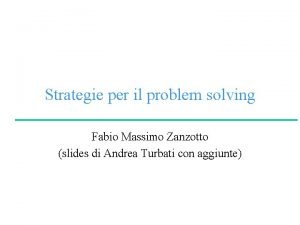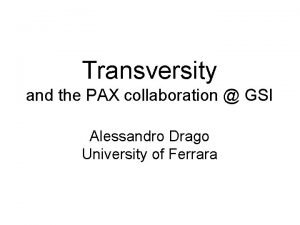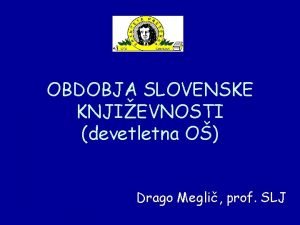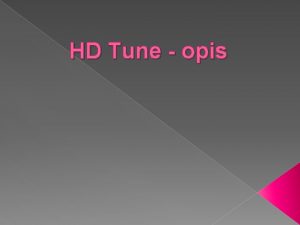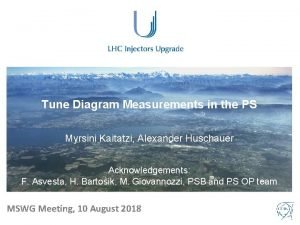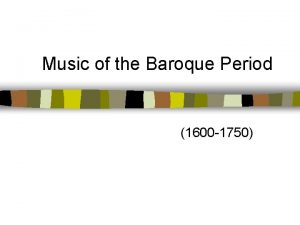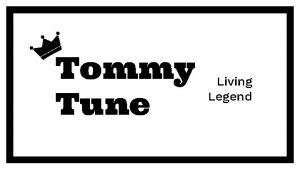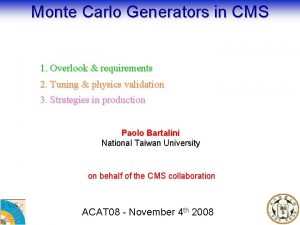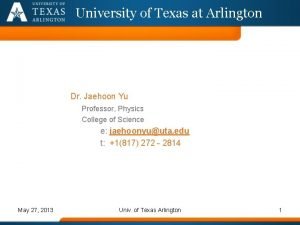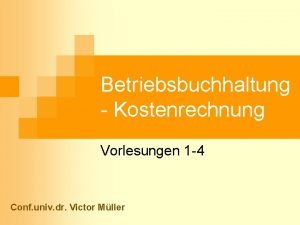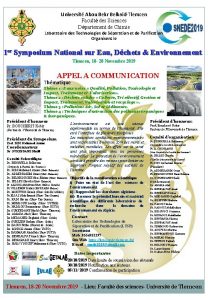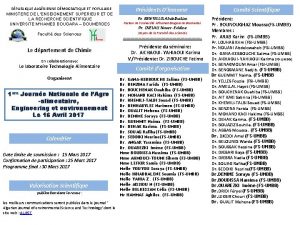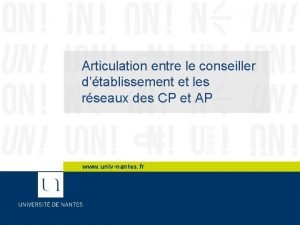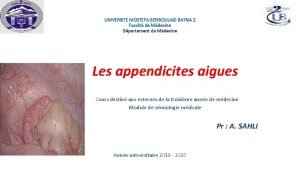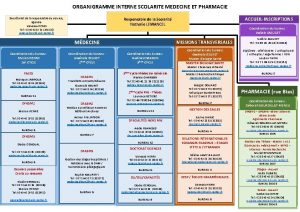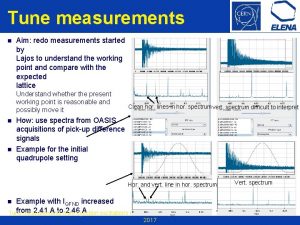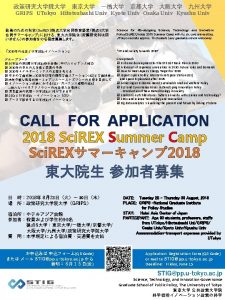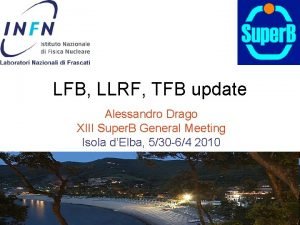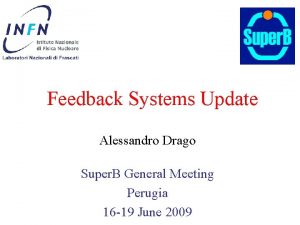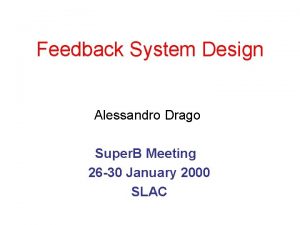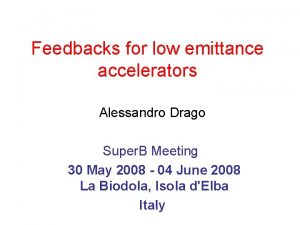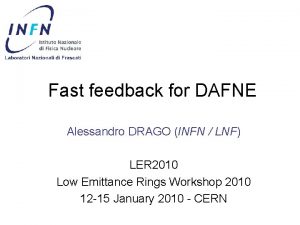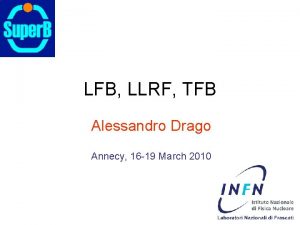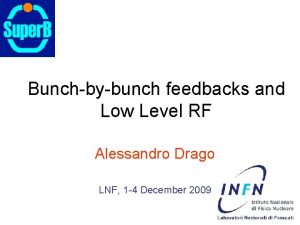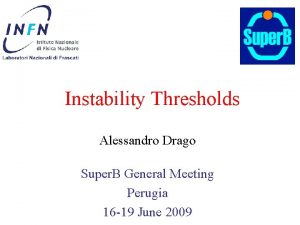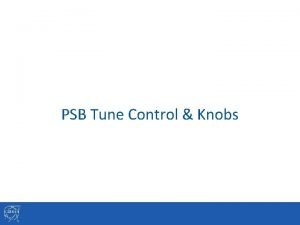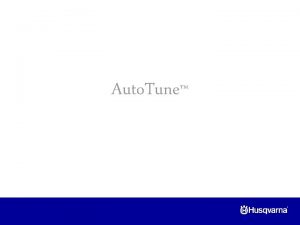Tune measurements Alessandro Drago INFNLNF Tor Vergata Univ



![From “Collins English-Italian Dictionary” 1 st Edition © Harper. Collins Publishers 1995 Tune [tjuːn] From “Collins English-Italian Dictionary” 1 st Edition © Harper. Collins Publishers 1995 Tune [tjuːn]](https://slidetodoc.com/presentation_image_h2/927a6c8085ef8049d973e57ec4695c4b/image-4.jpg)
![from http: //dictionary. reference. com/ tune [noun] 1. a succession of musical sounds forming from http: //dictionary. reference. com/ tune [noun] 1. a succession of musical sounds forming](https://slidetodoc.com/presentation_image_h2/927a6c8085ef8049d973e57ec4695c4b/image-5.jpg)




















![Recipe used for Elettra (Trieste) [from Marco Lonza] Elettra is a light source and Recipe used for Elettra (Trieste) [from Marco Lonza] Elettra is a light source and](https://slidetodoc.com/presentation_image_h2/927a6c8085ef8049d973e57ec4695c4b/image-26.jpg)



















- Slides: 45

Tune measurements Alessandro Drago INFN-LNF & Tor Vergata Univ. "Beam Dynamics meets Diagnostics" Workshop 4 -6 November 2015, Florence, Italy

Topics (not in order in this talk!) Definitions Physics Betatron oscillations Betatron sidebands Tune spread induced by e-cloud Tune shift given by beam-beam kick Methods Excitation types Instruments for the analysis Technology Monitors Kickers Receivers

First of all - the semantics The use of the term "tune" in circular accelerators is, in such a way, strange and funny: it is very common jargon word for synchrotron and storage ring users but it is much more specific in other fields. . .
![From Collins EnglishItalian Dictionary 1 st Edition Harper Collins Publishers 1995 Tune tjuːn From “Collins English-Italian Dictionary” 1 st Edition © Harper. Collins Publishers 1995 Tune [tjuːn]](https://slidetodoc.com/presentation_image_h2/927a6c8085ef8049d973e57ec4695c4b/image-4.jpg)
From “Collins English-Italian Dictionary” 1 st Edition © Harper. Collins Publishers 1995 Tune [tjuːn] A (noun) (melody) he gave us a tune to change one's tune (fig) to the tune of (fig: amount) melodia, aria ci ha suonato qualcosa cambiare tono per la modesta somma di B (noun) in tune (instrument) out of tune (instrument) to sing in tune to sing out of tune in tune with (fig) accordato[-a] ; (person) intonato[-a] scordato[-a] ; (person) stonato[-a] cantare senza stonare in accordo con C (verb) to tune in (to) [radio, TV] sintonizzarsi (su)
![from http dictionary reference com tune noun 1 a succession of musical sounds forming from http: //dictionary. reference. com/ tune [noun] 1. a succession of musical sounds forming](https://slidetodoc.com/presentation_image_h2/927a6c8085ef8049d973e57ec4695c4b/image-5.jpg)
from http: //dictionary. reference. com/ tune [noun] 1. a succession of musical sounds forming an air or melody, with or without the harmony accompanying it. 2. a musical setting of a hymn, poem, psalm, etc. , usually in four-part harmony. 3. the state of being in the proper pitch: to be in tune. 4. agreement in pitch; unison; harmony. 5. proper adjustment, as of radio instruments or circuits with respect to frequency. 6. harmonious relationship; accord; agreement. 7. Archaic. frame of mind; mood. [verb (used with object), tuned, tuning. ] 9. to adjust (a musical instrument) to a correct or given standard of pitch (often followed by up). 10. to adapt (the voice, song, etc. ) to a particular tone, to the expression of a particular feeling, or the like. 11. to bring (someone or something) into harmony. 12. to adjust (a motor, mechanism, or the like) for proper functioning. 13. Radio and Television. to adjust (a circuit, frequency, or the like) so as to bring it into resonance with another circuit, a given frequency, or the like. to adjust (a receiving apparatus) so as to make it compatible in frequency with a transmitting apparatus whose signals are to be received. to adjust (a receiving apparatus) so as to receive the signals of a particular transmitting station. 14. to put into or cause to be in a receptive condition, mood, etc. ; bring into harmony or agreement. 15. Archaic. to utter, sound, or express musically. to play upon (a lyre). [verb (used without object), tuned, tuning. ] 16. to put a musical instrument in tune (often followed by up). 17. to give forth a musical sound. 18. to be in harmony or accord; become responsive. [Verb phrases] 19. tune in, to adjust a radio or television set so as to receive (signals, a particular station, etc. ). 20. tune out, to adjust a radio or television set so as to stop or avoid receiving (a station or channel). Slang. to stop paying attention to a person, situation, etc. 21. tune up, to cause a group of musical instruments to be brought to the same pitch. to begin to sing. to bring into properating order, as a motor: Before starting on our trip we should have the car tuned up.

THE PHYSICS OF ELECTRON STORAGE RINGS AN INTRODUCTION MATTHEW SANDS, SLAC-PUB-121, November 1970 A short pulse of a beam of electrons is injected into a vacuum chamber embedded in a more-or-less circular magnetic guide field. The guide field leads the electrons around in more-or-less closed paths to make a stored beam. -- The guide field has focussing properties which drive all electrons toward an ideal design orbit and cause them to execute lateral (radial and vertical) betatron oscillations about the ideal closed path. Note for beginners: a synchrotron is a circular accelerator with constant radius. A storage ring is a synchrotron with fixed energy and it is a type of circular particle accelerator in which usually pulsed particle beam may be kept circulating typically for many hours.

THE PHYSICS OF ELECTRON STORAGE RINGS AN INTRODUCTION MATTHEW SANDS, SLAC-PUB-121, November 1970 where β(s) = betatron functions in the two transverse coordinates x and y, Φ(s) =Phase variable of betatron oscillations, s = longitudinal coordinate and L = ring length =2π radius

An Introduction to the Physics of Particle Accelerators M. Conte-W. Mac. Kay, World Scientific Ed. , 1991 "The betatron tune is defined as the number of cycles of the betatron oscillation made by a particle during one full orbit. " "We have used QH and QV respectively for the orizontal and vertical betatron tunes and QS for the synchrotron tune. " "Some authors use the Greek letter v (nu) instead of Q and may replace the subscript with the corresponding coordinate. " QH, V = (N/2π) ∫ss+L ds/βH, V where the function β(s) is called the betatron function, N number of cells, L length of 1 cell

Social customs Usually the accelerator physicists use the term "betatron tune" or simply "tune" in place of the Matthew Sand's definition of "betatron number" Q is also more frequent in Europe in place of the Greek letter ν used in USA Subscript to Q and ν can be x and y or H and V More frequently the accelerator physicists use the term "horizontal or vertical tune" just for the fractional part of the betatron number. This is because the integer part usually does not change, while the fractional part often does.

The integer part of the betatron tune (or number) can be plotted with a method completely different from the technique used for the fractional part. mm m Above: a plot of the DAFNE e+ beam orbit showing the integer part of the betatron horizontal number (that is 5). The number of oscillations can be shown by kicking the beam by using a horizontal corrector magnet. In this case, the definition of betatron number seems to fit better than betatron tune.

The fractional part of Q The fractional part of Q is given by the frequency difference between one of the revolution harmonics and its betatron (H or V) sideband divided by the revolution frequency. As a consequence, Q is dimensionless. In this case the definition tune can be applied with appropriate reference to the standard meaning as in the dictionary. We can suppose that the tune word portrays how the instrument (the accelerator) plays the melody (the beam behavior) in tune or out of tune. Summarizing, what we usually do for getting the tune is to measure a frequency

The method Therefore the problem is now reduced to compute the beam transfer function. First of all we need the right excitation to shake the beam Then we need to receive the response signal coming from the beam in order to get the transfer function As third step we need to identify in the response, plotted in frequency domain, the peak that can be labeled as the tune (H or V). Noise can affect the identification. Last step: divide the delta frequency (peak frequency closest harmonic frequency) by revolution frequency to get the tune that is dimensionless. Very simple, isn't it ?

What kind of excitations ? a) Sweeping in frequency around the range in which we expect the tune b) Or, otherwise, generating white or pink noise to excite in parallel all the range of the interested frequencies c) The excitation signal needs to have the right amplification, so usually pass through power amplifier section. d) To be applied we need an electromagnetic device, called kicker. The shapes can be many but the most popular one is made by 2 parallel striplines (usually in copper), placed above and below the beam for vertical measurements or at right and left in the horizontal tune. e) The excitation voltage should be splitted in two path and applied to the two ports of the kicker with 180° phase to be effective, otherwise it does not work.

A network analyzer can be used for both functions: to excite the beam by a frequency sweep and to plot the response signal Two ports !

DAFNE stripline kicker (it can be used also as pickup) From DAFNE • In a kicker each electrode forms a transmission line with 50 Ohm characteristic impedance. • Electrode length: ~20 cm • Stripline thickness : ~1 mm • Connector type: “ 7/8 of inch”, useful for powerful signal • The feed-through (the piece between connector and stripline) is very critical because has to preserve the vacuum without attenuating the signal. • It is necessary to taper the kicker border to fit at the best the vacuum chamber dimensions


Stripline kicker • In order to use these device as excitation terminals, the voltage have to applied to the downstream ports with opposite signs and the “upstream” ports need to be terminated at 50 Ohm to avoid reflections and distorsione of the signals. • The magnetic and electric fields combined together cause a deflection due to the Lorentz force in the transverse plane: F=q(E + v x B) • The two contributes are summed if beam and e. m. Wave are travelling in opposite directions. • If particle and wave speeds are the same (ultra-relativistic beam) then from the TEM wave theory it will be |E| = |v x B| • In conclusion the applied force will be F=2 q. E if the kicker is driven by the downstream ports, otherwise the deflection forces (electrical and magnetic) would cancel them if the excitation will be applied to the upstream ports.

White/pink noise source • By software with random number routine and a digital-toanalog converter • By a mix of digital and analogue electronics, made by shift registers and operational amplifiers (see Paul Horowitz. Winfield Hill, The Art of Electronics, Cambridge University Press, 1995) • If many bunches are stored it can be useful to excite just one bunch and this is possible by using for example the bunch-by-bunch feedback that can send the noise to a precise bunch and only to that one. • I can be useful also to shake just one or few harmonics to limit the noise to the frequency range under observation. In this case it is necessary to have a carrier (a frequency synthesized) modulated in amplitude by the pink noise.

Different types of Beam Position Monitor installed in DAFNE

Beam Position Monitor: equivalent circuit of the button (with termination R 0) at the passage of the bunch of charged particles i= beam current, Vb= voltage induced by the beam passage b= chamber radius, r= button radius, Cb = button capacitance, c= light speed

Beam Position Monitor • Schematic Profile of a BPM, rectangular shaped in the picture. • From the voltages V 1, V 2, V 3, V 4 induced elettrostatically on the four electrodes it is possible to compute the beam transverse position. • As it is shown by the following formulae: • • • V 2+V 4−V 1−V 3 H = -----------V 2+V 4+V 1+V 3 • • • V 1+V 2−V 3−V 4 V = -----------V 2+V 4+V 1+V 3

Combiner and Hybrid • Sum and difference operations are performed directly on the pulse signal created by the bunch passage by two types of passive devices: combiner and hybrids: • a) combiner, that makes a sum of two syncronized pulses: it can be resistive (loosing 6 d. B, working also in DC) or coil-based (loosing 3 d. B, not working in DC) • b) hybrid, as for example the H 9 model by Macom (in the picture on the right), having two inputs (A and B) and two outputs: difference or DELTA is the D port while sum or SIGMA is the C port • H 9 are commercial components with 2 GHz bandwidth that can work well with single pulses • A perfect equalization of the delays given by the cable length is mandatory to get the goal for both devices (combiner and hybrid)

This is the instrument that we use at DAFNE. Before arriving to the Spectrum Analyzer the difference signal is amplified and filtered. Only one port !

Measuring betatron tunes Qx e Qy • In the upper picture an example of the beam oscillation frequency spectrum is shown: the two peaks are due to the betatron frequncy in horizontal (left) and vertical (right). • In the window below is shown the spectrogramm during the measures of the beta function: it is possible to see the tune shift induced by varying the quadupole setup. • The Q measure resolution is about 1 · 10− 4

When the tune measurement meets bunch-by-bunch feedback. . . • The bunch-by-bunch feedback systems have the goal to damp the instabilities that looked in frequency domain usually are exactly. . . where the betatron tune are placed. • It is clear that there is a poor compatibility between the tune measurements based on excitation and the feedback that act as damping force • The easiest solution is just turn off the feedback during the tune measurements. With a single bunch usually there are no problems even if the dynamic aperture is very low or the head-tail effect is strong can be difficult to maintain stored the shaken bunch • In this case, another solution could be to store a pattern of bunches with bunch current under the instability threshold and feedback turned off • Third solution: turn off the feedback for just one bunch then excite only that bunch. For a collider the bunch should be out of collision because the other beam can damp the tune or produce a tune shift. • Fourth solution: use the feedback response itself to get the tune (see later)
![Recipe used for Elettra Trieste from Marco Lonza Elettra is a light source and Recipe used for Elettra (Trieste) [from Marco Lonza] Elettra is a light source and](https://slidetodoc.com/presentation_image_h2/927a6c8085ef8049d973e57ec4695c4b/image-26.jpg)
Recipe used for Elettra (Trieste) [from Marco Lonza] Elettra is a light source and the electron beam has a long lifetime. It is important to measure the betatron tune during the regular working of the accelerator without disturbing the users. To do this the transverse feedback is turned off only for some selected bunches for a very short time. The feedback loop is opened for few millisecond (16 k values) putting at zero the feedback gain. The selected bunched start to oscillate and are recorded. Then the loop is closed again. A FFT is applied to the recorded signals. This is done on 3 bunches. Then the program makes an average of the transformed signals. A FFT is applied to the averaged signals, finding the peak and as consequence the tune value. The beamline user do not feel any effect. In some cases, for better exciting it is necessary to change sign to the FIR coefficient to give a sort of kick or to send a sinusoid at the frequency foreseen for the tune or by pink noise.

Betatron Tune Diagnostics for Super. KEKB (HER/LER) by Makoto Tobiyama (KEK Laboratory) • Global tune measurement for multi-bunch, small beam current • Gated tune measurement for pilot bunch only • PLL excitation of the pilot bunch using i. Gp 12 or Lock-in amplifiers

Global tune measurement schematics

A tune feedback is also in progress

Schottky noise & BBQ S-BBQ = Schottky-Base Band Tune This is a technique implemented at Tevatron, LHC and RHIC where it is necessary to a have a receiver of great sensitivity

By M. Gasior (CERN)

S-BBQ schematics

Another way for tune measuring that can be used if the feedback itself and the other colliding beam (if any) don't produce tune shift As it is shown in the picture above, applying a fft routine to the beam motion recorded by the feedback, it is possible to get a rejection negative peak given by the feedback gain at the frequency where the tune is located and where the S/N ratio is highest More feedback gain, more deep the rejection negative peak

This method can be used to evaluate the e-cloud effect. . . This is picture from DAFNE BPM showing how much the positron beam is affected by ecloud. Bunch spacing =2. 7 ns Every group is made by 10 bunches followed by 15 empty buckets This strathegy is implemented to wait the e-cloud decay time The non uniformity of the bunch current is due to the e-cloud effect

This method can be used to evaluate the e-cloud effect. . . In this other picture there are positron (red) and electron (blue) beams. The two beams are not colliding The electron bunch train has uniform current for each bunch.

Mitigation tools & diagnostics The DAFNE vacuum chamber is made by aluminium without any coating, maybe the best source of parasitic e-cloud. To mitigate the e-cloud in DAFNE we have installed solenoids in the drift section and clearing electrodes in bending and wiggler magnets (12 in total) One of the 3 diagnostic tools that we use for evaluating solenoids and clearing electrodes, is based on single bunch betatron tune measurements This is done by the bunch-by-bunch feedback systems using the rejection negative peak taken on a long pattern (32 ms) for each bunch

Horizontal tune spread in the positron beam induced by e-cloud effect And shown at two different beam current (450 and 550 m. A), in blue with Clearing electrodes on, in red off.


Electron beam with 1 Ampere stored in 90 bunches no e-cloud effect , no tune shift along the bunch train horizontal tunes vertical tunes

Positron beam with 0. 7 Ampere stored in 90 bunches horizontal tunes with e-cloud clearing electrodes on at full voltage (8 inside bending magnets, 2 inside wiggler magnets)

Positron beam with 0. 7 Ampere stored in 90 bunches horizontal tunes with e-cloud clearing electrodes on at full voltage (only the 8 inside bending magnets)

Positron beam with 0. 7 Ampere stored in 90 bunches horizontal tunes with all e-cloud clearing electrodes off

Tune shift induced by the colliding beam Regular tune (positron vertical plane) Shifted tune induced by the electron beam

This sequence show the e+ Vert tune with 700 m. A, 600 m. A, 500 m. A of stored e+ colliding with 0 m. A, 600 m. A, 1300 m. A of e- beam. The tune shift is 0. 0093

Conclusion Betatron number or tune ? Q or ν ? Many methods for tune measurements Only in DAFNE 3 different tools are used: a regular sweeping network analyzer, a white noise source with a real time FFT analyzer, the diagnostic capability of the bunch-by-bunch feedback itself. Lepton and hadron circular accelerators use similar philosophy but different receivers.
 Valeria conte tor vergata
Valeria conte tor vergata Master business administration tor vergata
Master business administration tor vergata Infn roma tor vergata
Infn roma tor vergata Vqr tor vergata
Vqr tor vergata Simone bozzato tor vergata
Simone bozzato tor vergata Master of science in business administration tor vergata
Master of science in business administration tor vergata Fabio massimo zanzotto
Fabio massimo zanzotto Davide lauro
Davide lauro Msc finance and banking tor vergata
Msc finance and banking tor vergata Roma school of economics (tor vergata)
Roma school of economics (tor vergata) Alessandro drago
Alessandro drago Lorenzo drago
Lorenzo drago Obdobja slovenske književnosti ppt
Obdobja slovenske književnosti ppt Limerick esempi
Limerick esempi Pauling's rules oxoacids
Pauling's rules oxoacids Mario drago
Mario drago Drago jančar veliki briljantni valček
Drago jančar veliki briljantni valček Carmen drago
Carmen drago Oj djetešce moje drago vesela sam ti
Oj djetešce moje drago vesela sam ti Ivo senkovic
Ivo senkovic Drago cumurdzic
Drago cumurdzic Tune cms integration
Tune cms integration [email protected]
[email protected] Metaphor in poetry
Metaphor in poetry Fine tune pay rates
Fine tune pay rates Hd tune pro
Hd tune pro Metaphor in caged bird
Metaphor in caged bird Tune blessing
Tune blessing Tune diagram
Tune diagram It is possible to fine-tune your emotional style by
It is possible to fine-tune your emotional style by Our vacuum hums a happy tune while it cleans.
Our vacuum hums a happy tune while it cleans. Noel hymn tune
Noel hymn tune Hymn tune sung to a german religious text
Hymn tune sung to a german religious text Tommy tune bio
Tommy tune bio Tune cms integration
Tune cms integration Examples of falling intonation sentences
Examples of falling intonation sentences Univ of texas arlington
Univ of texas arlington Mathematische kostenauflösung beispiel
Mathematische kostenauflösung beispiel Mail univ ouargla
Mail univ ouargla Fs boumerdes
Fs boumerdes Univ valenciennes ent
Univ valenciennes ent Prodoc univ nantes
Prodoc univ nantes Pharmacie.univ-batna2
Pharmacie.univ-batna2 Tracto rubroespinal
Tracto rubroespinal Httpsfa
Httpsfa Organigramme de pharmacie
Organigramme de pharmacie






